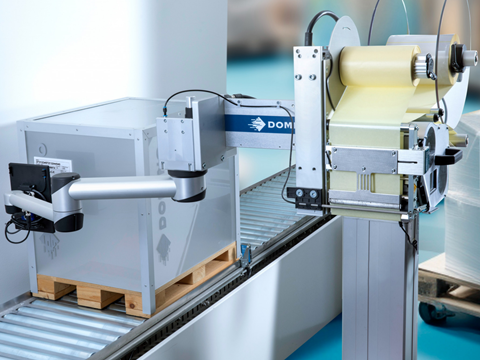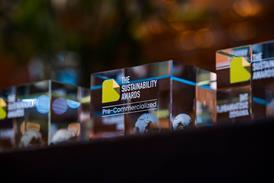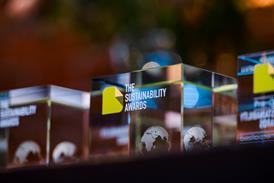
Domino has announced the launch of its new Mx350i-eP electric pallet labeller, designed for improved efficiency and said to require up to 40% less energy and up to 50% less factory air than previous generation pallet labellers.
The Mx350i-eP is said to require up to 40% less energy and up to 50% less factory air than previous generation pallet labellers due to its electrically driven applicator. Each labeller is reportedly 60% lighter and has a 40% smaller footprint than previous models due to the removal of safety guarding, resulting in an overall reduction in the shipping volume of packaging material by up to 60%, helping to lower transport emissions.
Domino says the Mx350i-eP has been designed with intelligent technological enhancements to allow for operation without additional safety guarding, enabling seamless integration onto pallet labelling lines and easy operator access to the machine. Features include an applicator arm designed to reduce pinch points and with built-in collision detection functionality to automatically stop and safely move away in the event of a collision or failure.
Apparently, the flexible arm applicator provides a wide range of motion for labelling on the front, side, or back of full, half, or part pallets. It also allows for variance in pallet location, with the ability to search for a pallet by up to 100mm in any direction along the horizontal plane of application.
An optional camera system within the label applicator provides the capability to check and verify codes on labels for accuracy and reliability and allows for the automatic reapplication of labels in the event of an error, to reduce the risk of waste and stop incorrect labels or codes entering the supply chain.
Alongside the Mx350i-eP, Domino is also introducing a new print and apply unit for flexible box labelling - the Mx351i-eC – said to require up to 80% less energy and 90% less factory air than previous generation box labellers. The Mx351i-eC features a flexible electric arm for corner-wrap, top, front, and rear labelling applications. Domino adds that the new systems are optimized to support maximum label adhesion while reducing stress on box.
Last summer, Domino sought to support the transition into label-free beverage bottles with its range of Bottle Closure Printing Stations, designed to print variable data and machine-readable codes onto HDPE bottle caps and closures. The stations were customizable to suit various production environments, including options for the near-line printing loose bottle caps and closures at high speeds.
In November 2024, researchers from the University of Birmingham revealed they had designed a new type of photocurable resin made entirely from bio-sourced materials, which could be 3D printed, recycled, and then printed again. The new resin solution was said to be compatible with light-initiated printing techniques such as DLP, SLA or InkJet printing and provide high fidelity, with resolution down to 0.05mm.
If you liked this story, you might also enjoy:
The ultimate guide to the Packaging and Packaging Waste Regulation in 2024
How are the top brands progressing on packaging sustainability?
Sustainable Innovation Report 2024: Current trends and future priorities
Everything you need to know about global plastic sustainability regulation





















No comments yet